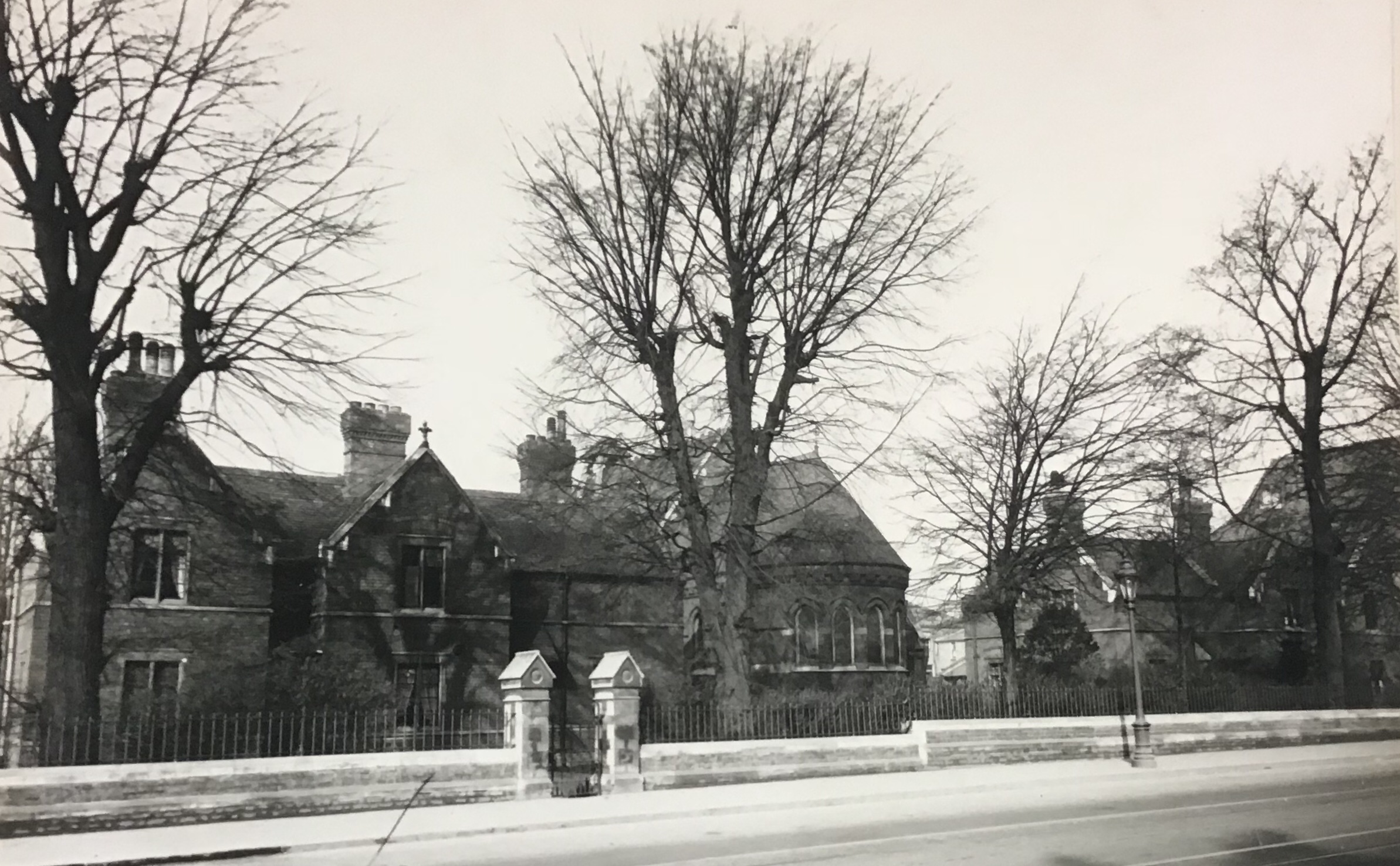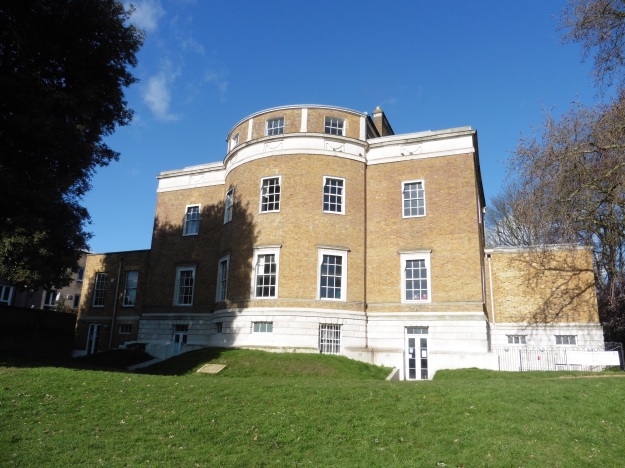Streets having their names changed is nothing unusual – we’ve covered it a couple of times before with Dermody Road (formerly Hocum Pocum Lane), Waite Davies Road (formerly (Butterfield Street). Similarly, on the other side of Lee High Road the bottom of Dacre Park was previously known as Turner Road. Like the second two examples, there is fading evidence of a painted street sign bearing the earlier name. However, it isn’t as easy to decipher the former name, Robertson Street, due to multiple layers of faint paint, re-pointing and a burglar alarm. In a pair of blog posts we’ll tell the history of the street – from its building to the present day.

The builder of the original part was someone we’ve covered several times before, John Pound, mainly in relation to his house building but also shops on Burnt Ash Road, pubs and Lee Public Halls. The street was built by Pound around 1862 (1), with applications made to the Board of Works that March for drainage connections. The land was owned by Lord Northbrook, although it doesn’t seem to have been farmed as part of Lee Manor Farm – it isn’t in the farm map of 1846 – and the estate seems to have retained the freehold post development (2) as permission was sought from Lord Northbrook’s agent for some work.
The homes were unlike most of those in the rest of the area at the time. The arrival of the railway in Blackheath had seen substantial homes with space for servants built to the north of Lee High Road. The function of these smaller houses was similar to those in Lee New Town – providing homes for the servants who didn’t ‘live-in’ and working classes of mid-Victorian Lee. There was another function too, large-scale housing development in what was then suburbia needed somewhere for the building labourers and trades to live in an era without cheap public transport. Pound seems to have done the same around Waite Davies Road and Summerfield Street for his brickworks in South Lee. It was a pattern followed by Cameron Corbett with houses in Sandhurst Road a few decades later.
Pound also seems to have built the neighbouring Hedgely Street – he made an application for sewer connections in 1868 (3). The street was adopted and paved in 1871 at a cost of 4/6d on the rates for occupiers – not the landlord (4).
So, who were the early occupants? We’ll look at the first 20 houses in the 1871 census, the first census they appeared in; while the numbers appeared as consecutive in the census reports it isn’t clear whether this was the case on the ground. The numbering is now odds and evens. The shops have been ignored for now, but may be returned to in a later post.
The majority (52%) of heads of household were working in the building trade, mainly skilled trades with the remainder split between various forms of domestic service and other trades. Relatively few of the women worked, but those who did, tended to be listed in the census as charwoman or laundress. While not in in the houses reviewed in detail, elsewhere in the street there were farm labourers housed – presumably still working at either Burnt Ash, Lee Manor or Horn Park which were all still working at that stage.
Almost half of the houses were either home to two households or took in a lodger, there were some very overcrowded homes as a result – 13 lived at no 17 for example. Almost all the households had children.
A decade later the average number in each house was 6.7 (it had been 5.5 in 1871), mainly due to an increase in lodgers and shared houses. More women were working, although the trades were mainly around washing, ironing and cleaning. Male employment had changed little too, the majority working in the building trades.
Unsurprisingly, there was some crime relating to the street, a fair amount of it alcohol related. John Mahoney had to be removed by heavies from the Tiger’s Head for being drunk and aggressive. He then went over the road to what is now referred to as the New Tiger’s Head, but press reports called the Little Tiger, where he was arrested after falling asleep drunk. He then violently assaulted the arresting officer for which he spent 6 weeks in prison (5).
Robert Stow was found guilty of assaulting a police officer after being arrested for being drunk and disorderly outside the nearby Duke of Edinburgh – his defence was that he didn’t know it was a policeman and that he’d had too much rum to drink cut no ice with the magistrates. He was fined 20/- or 2 weeks in prison (6).
Theft wasn’t completely absent though – Thomas Upton (23) a labourer from 19 Robertson Street charged with stealing 25 hens from Blackheath Park and then selling them in Greenwich. He was sent to prison for 14 days (7).
The western side of the terrace backed not onto the Quaggy, as it does now, but onto a path from that broadly followed what is now Aislibie Road. After the floods in 1878 and probably also to allow better development of the land that was to form Lampmead Road, the Quaggy was deepened, straightened and took the route of the path. The differences are clear between the 1863 (top map below) and 1893 visits of the Ordnance Survey Cartographers.

The extension of the street to the northern side of the Quaggy seems to have happened around 1885 following the piecemeal sale of the Lee House estate. The builder may well have been George Mitchell; he made the application for connecting the new homes Brightfield Road to the existing sewers in what was still referred to as Robertson Street. John Pound asked for money for the connection (8). It is assumed that these would be the homes that are now numbered 109 to 127 Brightfield Road (some of which are pictured below), but could have been those to the south over the Quaggy.

Three years later a decision was made by the Metropolitan Board of Works in March 1888 to change street names in the area. It seems that Lampmead Road was created, it had originally been a dog-leg of Lenham Road going towards Lee High Road. The biggest change was in relation to Brightfield Road – from 1883 it had run from Old Road and then dog-legged around to the new homes built by George Mitchell. The section from Old Road now became Aislibie Road and Brightfield Road, while shortened to the north took expanded over the river and Robertson Street was no more (9). In addition to the remains of the painted sign, a stone one remains and is now part of a garden wall.
The new Brightfield Road had changed a lot by 1891 compared with the last census for Robertson Street. John Pound’s building work had finished in the area and only 8% of the heads of household at the eastern end of the street were working in the building industry, just over a third were servants – mainly jobs relating to horses with the remainder a wide variety of manual jobs. As was the case a decade earlier a lot of the women worked – mainly as dressmakers and laundresses. Most households had children and most of the houses were either shared or homes to lodgers too – overcrowding remained, although it was less bad than in 1881 – the average was 5.8 rather than 6.7 a decade earlier.

There were a few sales of the houses which seemed to be all tenanted over the next few years. In 1892, 111 -125 (odds) were up for sale at auction. These are the larger houses backing on to Manor House Gardens, then let as a military crammer school before the House and Gardens were sold to the London County Council in 1898. The particulars of the sale of the houses in Brightfield Road noted the proximity to Lee and Blackheath stations. Each house was ‘conveniently arranged for two families. Let to very respectable tenants at 12/- a week.’ There were unexpired leases of 92 years (10).
Three years later some more of the later houses, 75-79 which were adjacent to the original houses were sold – they were advertised as being on long leases, having a weekly rent of 12/- and an annual ground rent of £5 (11).
The change in name didn’t stop crime relating to the street in 1897, Emma Agate was arrested for theft of a large number of garments from Lee Public Halls Steam Laundry (in early 2021 home to Travis Perkins off Holme Lacey Road) where she worked as an ironer, she was found with a number of pawn tickets. She denied the charges but was remanded in custody (12).
There were a couple of bigamy cases – William James was charged with bigamously marrying Mary Bator of number 61 in 1889 (13). Four years later, Walter Garland admitted to a bigamous marriage to Alexandra Taylor of 60 Brightfield Road (14).
We’ll leave Brightfield Road at the end of the 19th century, returning in the second part to cover the 20th century and beyond.
Notes
- Kentish Mercury 22 March1862
- Kentish Independent 01 June 1872
- Kentish Independent 10 October 1868
- Kentish Independent 16 December 1871
- Kentish Mercury 18 June 1870
- Kentish Mercury 30 October 1875
- Kentish Independent 10 April 1886
- Kentish Independent 02 May 1885
- Kentish Mercury 9 March 1888
- Kentish Mercury 25 July 1892
- Kentish Mercury 29 September 1895
- Woolwich Gazette 27 August 1897
- Kentish Mercury 13 June 1890
- Woolwich Gazette 27 April 1894
Credits
- The maps are on a Non-Commercial Licence via the National Library of Scotland
- All the census and related data came via Find My Past (subscription required)
- The photo of the stone sign is courtesy of Frederic Heffer



























































